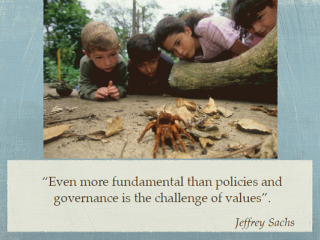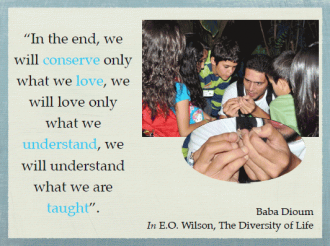10/04/2014
Valuing biodiversity: Bioliteracy and education - Rodrigo Gámez-Lobo -
It is increasingly evident that the future of biodiversity, both at the national and global scale, will be largely determined by the decisions of our political, governmental, social, religious, scientific and business leaders on how we, as a community, relate to the environment. But equally important for the same purposes will be the decisions we make as individuals.
Reaching the required consensus to make and implement those decisions will be largely determined by the shared awareness that our wellbeing depends entirely on nature, as well as the steps and actions that we must take to conserve it and use it sustainably.
INBio, Costa Rica´s National Biodiversity Institute actively promotes the idea that such awareness may be attained through bioliteracy, a concept defined as “a dynamic hands-on continuous learning process that empowers the individual to appreciate biodiversity, embrace an ethics of respect for life, and assume responsibility in the management and conservation of all living beings and ecosystems. Behavioral changes will favor a harmonious relationship with nature and thus a human sustainable development will be achieved”.
Scientists and educators agree that children are innate beginning explorers and naturalists, and also in parallel, that we humans have an inborn attraction to nature. For this reason the introduction to the natural sciences and the stimulation of such attraction and appreciation must ideally be made in those early years. An additional important practical consideration is that if the learning process is accompanied by pleasure and emotion, it will stay with the individual for the rest of his life.
These considerations have been taken into account by INBio and implemented in pilot practical initiatives based on a constructivist approach, that provide valuable experiences and methodologies for wider application or replication through the appropriate educational channels and entities, both at the local or national level.
One of these experiences has been the development and operation of an interactive recreational and educational biodiversity theme park “INBioparque”, where children and adults of mainly urban areas have the opportunity to enter in direct contact with nature, being exposed to hands-on learning experiences, which enable them to begin or reinforce their bioliteracy process.
“Cyberhives” is an innovative methodology conceived by INBio for the teaching of biodiversity and implemented in grade and high schools of rural areas, to stimulate students to learn and value the biodiversity of their own communities. This is achieved through research projects, which employ a “virtual communities of learning” methodology, based on the use of the classroom, natural spaces and the cyberspace.
“Enjoy sciences”, is another creative and challenging, constructivist and entertaining experience for students, using the same interactive approach with nature, which stimulates them to develop scientific thinking and a genuine interest or curiosity for the natural and exact sciences.
At INBio we believe that the wide application of these and other similar or equivalent approaches to promote bioliteracy, particularly in our younger generations, will contribute to the achievement of the first of the Aichi targets, making people … “aware of the values of biodiversity and the steps they can take to conserve and use it sustainably”.
(Rodrigo Gámez-Lobo, President, Instituto Nacional de Biodiversidad (INBio), The MIDORI Prize 2012 Winner)












